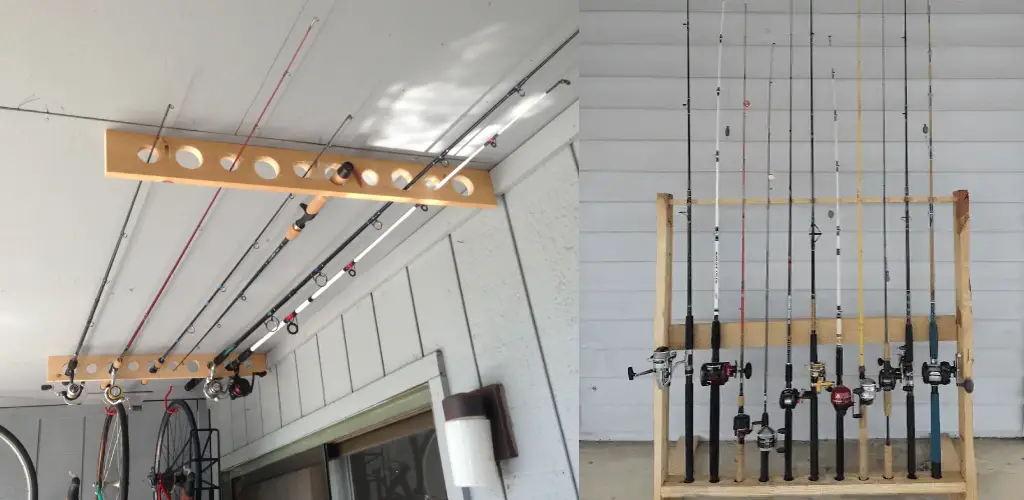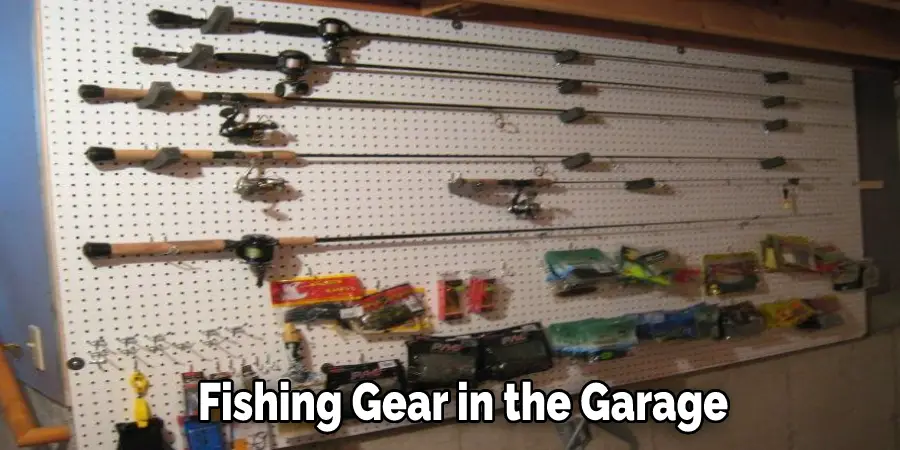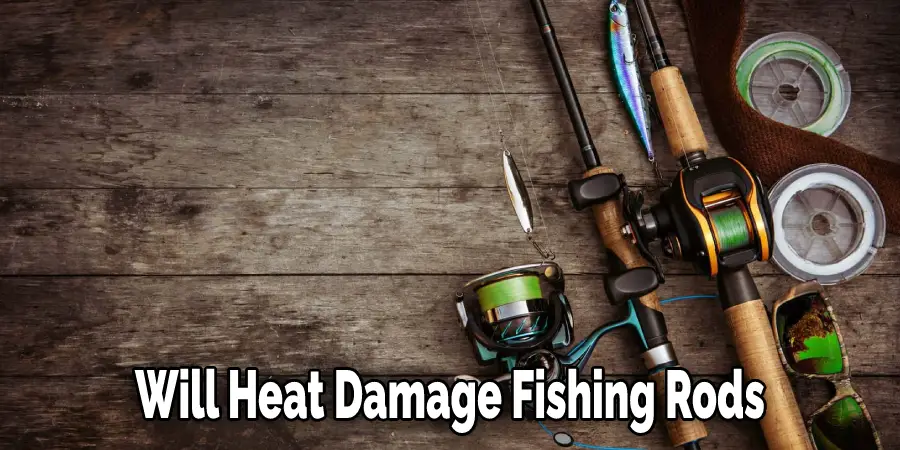Do you have a passion for fishing? If so, you know that your fishing rods are important tools to be stored properly. Fishing rods can be very expensive, so it’s important to take care of them and store them to prevent damage. In this blog post, we will give you tips on how to store fishing rods in garage. Read on to learn more!

Summary: Storing fishing rods in your garage can be challenging if you don’t have the right storage system in place. To properly store fishing rods in a garage, keeping them organized and protected from damage is essential. You can use PVC tubes or fishing rod holders to keep them upright and prevent them from bending or getting tangled. It’s also important to avoid placing them near any sources of heat or moisture.
Why Should You Store Fishing Rods in Garage?
Fishing is a beloved pastime for many, but it can be difficult to find the proper storage for all necessary gear. Storing fishing rods in the garage is a great solution because it keeps them out of the way and helps to protect them from the elements. Garage storage also keeps your tackle organized and within easy reach.
If you have a lot of fishing gear, consider investing in a storage rack specifically designed for fishing rods. This will help prevent your rods from becoming tangled and make it easy to grab the one you need when headed out on a fishing trip. With proper care and storage, your fishing rods will last for years.
How to Store Fishing Rods in Garage Step by Step Guide
Step 1: Assess Available Space
Before storing your fishing rods in the garage, assess the available space and determine where you can allocate an area specifically for rod storage. Look for a spot that is dry, protected from extreme temperatures, and away from any potential hazards or obstructions.
Step 2: Choose a Storage Rack or Holder
Select a storage rack or holder that suits your needs and fits the available space. There are several options to consider, such as wall-mounted racks, ceiling-mounted racks, freestanding rod holders, or individual rod sleeves. Choose a storage solution that provides proper support and protection for your fishing rods.
Step 3: Clean and Prepare the Rods
Before storing your fishing rods, it’s important to clean them thoroughly. Remove any dirt, debris, or fishing line residue from the rods. Wipe them down with a damp cloth and mild detergent if necessary. Ensure that the rods are completely dry before proceeding to the next step.
Step 4: Disassemble the Rods
To maximize space and minimize the risk of damage, disassemble your fishing rods. Carefully remove the reel, if applicable, and detach any interchangeable parts. Follow the manufacturer’s instructions for disassembling your specific rod model to avoid any accidental breakage or damage.
Step 5: Organize the Rods
Organize your fishing rods based on their length, type, or frequency of use. This will help you easily locate the rod you need when you’re ready to go fishing. Consider grouping similar rods together and arranging them in a logical and accessible order.
Step 6: Install the Storage Rack or Holder
Install the chosen storage rack or holder according to the manufacturer’s instructions. Whether it’s a wall-mounted rack or a freestanding rod holder, ensure that it is securely attached and capable of supporting the weight of your fishing rods. Use appropriate mounting hardware and tools for a sturdy installation.
Step 7: Position the Rods in the Holder
Place your fishing rods in the storage rack or holder. Depending on the design of the holder, you may need to insert the rod handles into designated slots or hang the rods vertically or horizontally. Make sure the rods are secure and won’t easily slide or fall out of the holder.
Step 8: Utilize Rod Sleeves or Socks
If you prefer individual protection for your fishing rods, consider using rod sleeves or socks. These are soft covers designed to safeguard the rods from scratches, dust, and other potential damage. Slide the rod sleeves onto each rod or wrap the rods in individual socks before placing them in the storage rack or holder.
Step 9: Avoid Excessive Weight or Pressure
Ensure that you don’t overload the storage rack or holder with too many rods or place heavy items on top of the rods. Excessive weight or pressure can cause the rods to bend or break over time. Distribute the rods evenly and leave enough space between each rod to prevent any unnecessary strain.
Step 10: Consider Climate Control
If your garage is prone to extreme temperature fluctuations or high humidity levels, consider implementing climate control measures. Extreme heat or moisture can damage the fishing rods. Install a dehumidifier or consider sealing the garage to maintain a more stable environment for your fishing gear.
Step 11: Regularly Inspect and Maintain
Regularly inspect your stored fishing rods to ensure they remain in good condition. Check for any signs of damage, such as bent sections, loose guides, or reel seat issues. If you notice any problems, address them promptly to prevent further damage. Additionally, periodically clean the storage rack or holder to remove any accumulated dust or debris.
Step 12: Security Measures
If you’re concerned about the security of your fishing rods, especially if you store them in an accessible area of the garage, consider implementing additional security measures. Install a lockable cabinet or storage unit to keep your rods safe from theft or unauthorized access. You can also consider installing a security system or surveillance cameras to provide an extra layer of protection for your valuable fishing gear.
Step 13: Store Reels and Accessories Separately
To keep your fishing rods organized and prevent damage to the reels and accessories, consider storing them separately. You can use small tackle boxes or compartments to store reels, fishing lines, hooks, and other accessories. Keep these items in a designated area of the garage, such as a shelf or drawer, to ensure they are easily accessible when needed.
Step 14: Label and Inventory
Maintaining an inventory of your fishing rods can be helpful, especially if you have a large collection. Label each rod or use color-coded tags to identify different types or sizes. This will make it easier to locate specific rods when you’re planning your fishing trips. Additionally, periodically review your inventory to ensure all rods are accounted for and in good condition.
Step 15: Consider Vertical Storage Options
If you have limited floor space in your garage, consider utilizing vertical storage options for your fishing rods. Install vertical rod holders or racks that allow you to store the rods upright against the wall. This not only saves space but also keeps the rods easily accessible and minimizes the risk of accidental damage.
Step 16: Protect from Sunlight
Direct sunlight can cause fading, discoloration, and deterioration of your fishing rods over time. Therefore, it’s important to protect them from prolonged exposure to sunlight. If your garage has windows or skylights, consider covering them with blinds or curtains to block out the sunlight. Alternatively, position the storage rack or holder away from direct sunlight or use protective covers for the rods.
Step 17: Educate Family Members
If you share the garage space with other family members, educate them about the proper storage and handling of fishing rods. Make sure they understand the importance of treating the rods with care and avoiding any rough or careless handling that could result in damage.
Step 18: Seek Professional Advice
If you’re unsure about the best storage method for your fishing rods or if you have unique requirements, seek advice from professionals or experienced anglers. They can provide valuable insights and suggestions based on their expertise and personal experiences.
By following these steps, you can effectively store your fishing rods in the garage, keeping them organized, protected, and readily accessible for your next fishing adventure. Remember to assess the available space, choose a suitable storage rack or holder, clean and prepare the rods, disassemble them if necessary, and organize them accordingly. Install the storage rack securely, position the rods in the holder, and consider using rod sleeves or socks for additional protection. Avoid excessive weight or pressure, maintain a suitable climate, regularly inspect and maintain the rods, and implement security measures if needed. With proper storage, your fishing rods will remain in excellent condition, ready to accompany you on many successful fishing trips.
How do you Prepare to Store Fishing Gear in the Garage?
As the weather begins to cool and days grow shorter, many people begin to think about putting their fishing gear away for the winter. However, simply tossing everything into the garage is a recipe for disaster. In order to ensure that your gear is in good condition when spring rolls around, it is important to take the time to prepare it for storage.
Begin by giving all of your tackle a thorough cleaning. This will remove any dirt or grime that could cause corrosion over the winter months. Next, inspect your equipment for any signs of wear or damage. Any damaged items should be repaired or replaced before being stored.

Once everything is clean and in good working condition, you can begin packing it away. It is important to use airtight containers to protect your gear from moisture and pests.
By preparing your fishing gear for storage properly, you can rest assured knowing that it will be in good condition when the next season starts.
Frequently Asked Question
Is It Ok to Leave Fishing Rods Outside?
Leaving fishing rods outside can be a bad idea, as they can get damaged by the weather. Instead, it’s better to store them in a garage or shed where they will be protected from the elements.
Can You Store Fishing Rods Horizontally?
Some people choose to store their fishing rods horizontally in their garage. This will depend on how much space you have and how many fishing rods you have. If you have a lot of fishing rods, you may need to store them vertically. You can also use a fishing rod rack to store your rods.

Is It Safe to Store Fishing Rods in Garage?
Yes, it is safe to store fishing rods in the garage if they are not exposed to the elements. Try to find a place in the garage that is dry and protected from the wind. If you don’t have a spot like that, you can also store them in your house; just make sure they are out of the way, so people don’t trip over them.
Will Heat Damage Fishing Rods?
There is some debate over whether or not heat will damage fishing rods. Some people say that if you store your fishing rods in a garage, the heat from the sun could cause the rod to become warped and useless. Others say that the heat will not be an issue as long as you don’t leave your rods in the direct sunlight.
Conclusion
Fishing rods can be stored in a garage in different ways, depending on the type of fishing rod and how much space is available. Some common storage methods are hanging them on a wall or storing them in a cabinet or rack. If you have limited space, you can also store fishing rods by wrapping them around a PVC pipe. Thanks for reading our post about how to store fishing rods in garage.
You can check it out to Keep Garage from Flooding
